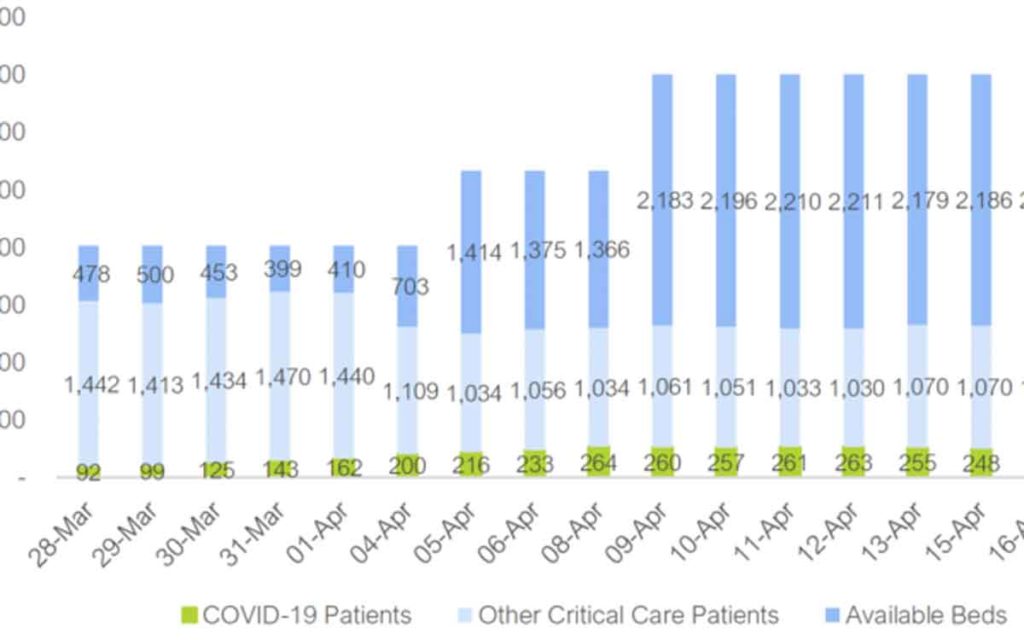
Ontario’s pandemic countermeasures have successfully kept the demand on healthcare resources well within capacity limits
Everyday, Canada’s federal, provincial and municipal governments publish – and the media obligingly report – daily COVID-19 numbers that tell us a lot of what we don’t need to know, and just a little of what’s important.
Here’s how to tell the difference.
Number of COVID-19 Cases
This is the biggest number and the one governments – and the media – tend to focus on. It’s also one of the key metrics public health officials tell us is important as they decide when to loosen restrictions and reopen the economy.
But, the number of cases is pretty much irrelevant.
The number of people diagnosed with COVID-19 infection each day is a function of (a) how many people are infected – which is an important thing to know – and (b) how many people are tested.
And, there’s the rub. If you want the number of new cases to be zero – a desirable goal – all you have to do is stop testing people. No tests. No confirmed diagnoses. No new cases. Simple.
But, that result wouldn’t be very meaningful would it?
In fact the number of new cases is a largely meaningless piece of information. If we tested twice as many people tomorrow compared to today, the number of cases tomorrow would go up significantly. But, would that mean more people are sick? Maybe. Maybe not.
I’m sure the case numbers are more meaningful to public health officials – but only if they divide the daily new case count by the daily test count to track trend rates. You and I aren’t doing that – so you and I can safely ignore the daily case count entirely.
The number of deaths
The death count each day is a more useful piece of information. People tend to come in two types – alive or dead. It’s generally a binary option. Usually, the difference is pretty definitive.
So, the number of people dying due to COVID-19 is a tangible fact. Whether they had symptoms or not – whether they were tested or not – if they’re dead, they’re dead. If they died of COVID-19 they died of COVID-19.
If the daily death count is increasing – that’s a bad sign as it means the problem is growing. If the daily death count is decreasing – that’s a better sign because it means the problem is still growing – but not as fast.
When the daily death count reaches zero – that’s great news. It means we’ve largely licked the infection and, while people may still be infected and/or still getting sick, they’re not dying anymore.
Of course, there will always be some fuzzy edges on this number because we may not always know the correct cause of death. Many people dying in seniors homes may be recorded as COVID-19 related deaths even if they were not – and vice versa. Likewise, others who were in the process of dying in hospital of something else before they contracted COVID-19 – may or may not have been tipped over the edge by COVID-19 and that may or may not be reflected on their death certificate.
But, generally, death count is a much more useful and reliable measure. But, still – the number of deaths per day doesn’t really tell us when we’re “flattening the curve” – because flattening the curve does not mean preventing COVID-19 related deaths.
Flattening the curve is all about preventing our hospitals from being overloaded with COVID-19 cases. Therefore, the only truly relevant number being released each day by government officials is…
The number of Hospital and ICU admissions
The number of people admitted to hospital – and within hospital to Intensive Care Units – is a hard number. Somebody either is or is not in a bed. There is little room for grey area.
Likewise, the number of beds is known.
The numbers we should all be looking at are the numbers of hospital – and ICU – admissions. We need them to remain well below the capacity threshold of our healthcare system. This is the true gauge of when and how much we can lift the pandemic restrictions on our freedoms.
According to Ontario’s Financial Accountability Office, there are 22,400 acute care hospital beds in that province – 2,012 of which are configured for critical care. At the outset of the pandemic, Ontario had 906 empty acute care beds, 357 available critical care beds (356 with ventilators). The FAO reports Ontario increased its critical care capacity significantly to respond to the pandemic by adding (0r emptying) 9,349 acute care beds, 2,077 critical care beds (2,057 with ventilators).
In other words, Ontario hospitals had capacity for about 9,300 new acute care and just over 2,000 new critical care COVID-19 patients.
According to Ontario’s official COVID-19 summary for April 28, 2020:
Number of COVID-19 hospitalizations in Ontario: 957 – about 10% of capacity.
Number in ICU: 239 (187 on ventilators) – just over 10% of capacity.
So far, Ontario’s countermeasures have succeeded in keeping the number of COVID-19 cases well below the province’s healthcare capacity – which was the goal of flattening the curve.
Originally published on towhey.com




















